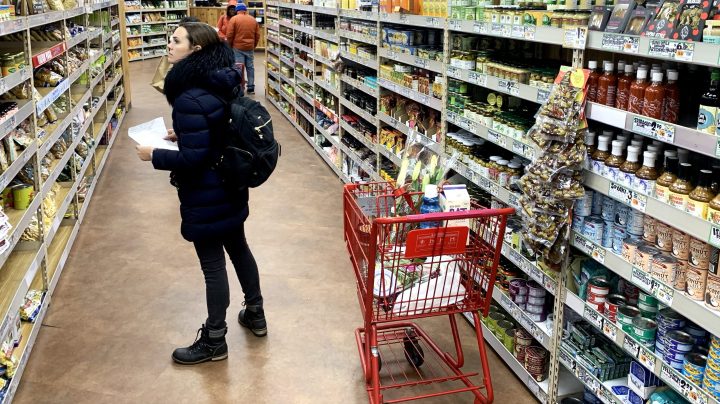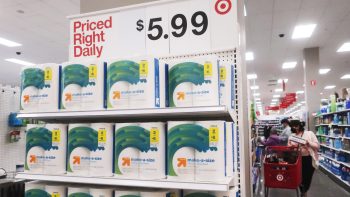
How store brands went from shamed to chic

Once rejected as a poor man’s version of name-brand products, store brands are now enjoying a certain level of cachet. And the profits — and savings — they offer are the real thing, experts say.
With prices going up at the grocery store, consumers are changing their habits. In earnings report after earnings report, companies say consumers are switching to private-label products. These are brands made by stores — think Walmart’s Great Value and Whole Foods Market’s 365. In 2021, private-label sales increased by almost $2 billion.
How did store brands grow into such a big market? To answer that we have to go back to the late 1970s. Inflation had been raging for more than a decade, the economy was coming out of a recession and an aisle of misfit foods was growing at grocery stores.
The products were called generics — copycat versions of brand-name foods. Their packaging was bright yellow or white and a bit cartoonish looking, with cans and boxes simply labeled “Beans” or “Dog Food.”
“It wasn’t very attractive, but people were looking for ways how to save money. And for retailers, they were seeing it as a way to meet consumer demand for cheaper products,” said Jan-Benedict Steenkamp, who has written two books on private labels. “Neither of the two parties really liked them so much.”
For stores, generics screamed, “low quality,” and shoppers were kind of embarrassed to buy them.
“Honestly, you don’t feel very good if you have that kind of things in your cart if you’re consuming it. So when good economic times came back, people drifted away from these generics,” Steenkamp said.
Generics almost died out until sometime in the 1990s, when stores changed their approach and became experts at making higher-quality copycats. Eventually, they morphed into a lifestyle. Think: devotees of Aldi and Trader Joe’s.
“Often the consumers don’t think of the Trader Joe’s private label as a private label,” said Kusum Ailawadi, a professor of marketing at Dartmouth College. “They think of it as exclusive products that I can’t find anywhere.”
Generics have evolved so much that we don’t even call them generics anymore. Private label is what the industry prefers.
And that’s kind of appropriate, because how they’re made is very private — mysterious, even. Peggy Davies, president of the Private Label Manufacturers Association, said store brands are sometimes manufactured by the big brand names that make the original product. And there are lots of theories on the internet about who makes what. A popular rumor is that Grey Goose distills Costco’s Kirkland Signature vodka.
“Could, could be,” laughed Davies. “But, you know, Kirkland’s not gonna tell you who makes it, and Grey Goose isn’t going to say they make it.”
When asked if it makes Kirkland’s vodka, Grey Goose parent company Bacardi sent a strongly worded email saying it does not. Kirkland won’t say who does either.
What about other copycat products? For instance, does Mondelēz International, the maker of Oreo cookies, make the suspiciously similar Wegmans version?
“[The manufacturer is] not necessarily a supplier that I would wanna give a shoutout to,” said Jeff Wishengrad, vice president of Wegmans brand.
Mondelēz International didn’t respond to a request for answers.
But often it is name brands manufacturing similar products for store brands. And that’s a win for both sides. The big manufacturer gets more business and a lower price for its own ingredients because it’s buying in bulk. And the store makes money. Wishengrad said more than half of Wegmans’ sales come from its own brand.
Christopher Durham, a private-label consultant, says store brands can also yield wider profit margins because retailers can skip the costs that come with running a national brand — things like product development, advertising, marketing and distribution.
And those savings are passed to the customer. On average, store brands cost 30% less than name brands.
But not every consumer is swayed by price alone. Steenkamp said the more emotional a buyer feels about a particular type of product, the less likely they are to buy the store brand. That’s especially true for hair products, baby formula and certain indulgences.
In the end, we are emotional buyers. And our feelings sometimes convince us the dupe is not as good as the real thing.
There’s a lot happening in the world. Through it all, Marketplace is here for you.
You rely on Marketplace to break down the world’s events and tell you how it affects you in a fact-based, approachable way. We rely on your financial support to keep making that possible.
Your donation today powers the independent journalism that you rely on. For just $5/month, you can help sustain Marketplace so we can keep reporting on the things that matter to you.

















